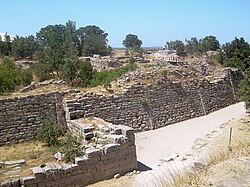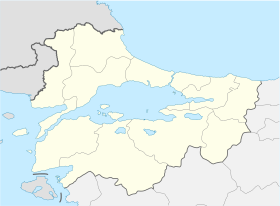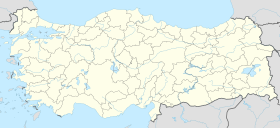ทรอย
| ที่ตั้ง | ฮีซาร์ลึก จังหวัดชานักคาแล ประเทศตุรกี |
|---|---|
| ภูมิภาค | Troad |
| พิกัด | 39°57′27″N 26°14′20″E / 39.95750°N 26.23889°E |
| ส่วนหนึ่งของ | Historical National Park of Troia |
| หมายเหตุเกี่ยวกับสถานที่ | |
| เว็บไซต์ | https://whc.unesco.org/en/list/849/ |
| ประเภท | วัฒนธรรม |
| ขึ้นเมื่อ | 1998 (ครั้งที่ 22) |
| เลขอ้างอิง | 849 |
| UNESCO Region | ยุโรปและอเมริกาเหนือ |
ทรอย (อังกฤษ: Troy; ตุรกี: Troya; กรีก: Τροία; ฮิตไทต์: 𒋫𒊒𒄿𒊭 Truwiša/Taruiša) หรือ อีเลียน (กรีก: Ίλιον, ฮิตไทต์: 𒌷𒃾𒇻𒊭 Wiluša)[1][a][2][3][4] เป็นนครสมัยโบราณที่ตั้งอยู่ในฮีซาร์ลึก ประเทศตุรกี โดยเป็นที่รู้จักจากการเป็นฉากในสงครามโทรจันในตำนานกรีก แหล่งโบราณคดีเปิดต่อสาธารณชนในฐานะสถานที่ท่องเที่ยว และได้รับการบรรจุเป็นแหล่งมรดกโลกของยูเนสโกใน ค.ศ. 1998
ทรอยถูกทำลายและสร้างใหม่หลายครั้งในช่วงที่มีการครอบครอง 4000 ปี ทำให้พื้นที่นี้แบ่งออกเป็นชั้นทางโบราณคดี 9 ชั้น แต่ละชั้นคือนครที่สร้างบนซากของนครยุคก่อนหน้า นักโบราณคดีเรียกชั้นเหล่านี้ด้วยตัวเลขโรมัน โดยทรอย 1 (Troy I) มีอายุเก่าสุด ส่วนทรอย 9 (Troy IX) มีอายุใหม่สุด
มีผู้เข้าตั้งถิ่นฐานในทรอยครั้งแรกประมาณ 3600 ปีก่อน ค.ศ. และเติบโตเป็นนครป้อมปราการขนาดเล็กประมาณ 3000 ปีก่อน ค.ศ. (ทรอย 1) ในบรรดาชั้นเก่า ๆ ทรอย 2 มีชื่อเสียงในด้านความมั่งคั่งและสถาปัตยกรรมอันโอ่อ่า ในช่วงยุคสัมฤทธิ์ตอนปลาย ทรอยได้รับการเรียกขานเป็นวีลูซาและเป็นรัฐบริวารของจักรวรรดิฮิตไทต์ ชั้นสุดท้าย (ทรอย 8-9) เป็นนครสมัยกรีกและโรมันที่ทำหน้าที่สถานที่ท่องเที่ยวและศูนย์กลางทางศาสนา เนื่องจากความเกี่ยวโยงกับตำนาน
ไฮน์ริช ชลีมันน์กับแฟรงก์ แคลเวิร์ตเริ่มต้นการขุดค้นแหล่งโบราณคดีนี้ใน ค.ศ. 1871 ทั้งสองพบส่วนหลงเหลือของที่อยู่อาศัยยุคแรกจำนวนมาใต้ซากนครสมัยคลาสสิก บางชั้นมีลักษณะคล้ายทรอยในวรรณกรรม ทำให้นักวิชาการบางคนสรุปว่ามีความจริงส่วนหนึ่งที่อยู่ใต้ตำนาน การขุดค้นในระยะหลังโดยผู้อื่นเพิ่มความเข้าใจสมัยใหม่ในพื้นที่นี้ แม้ว่าความสัมพันธ์ระหว่างตำนานและความเป็นจริงยังไม่เป็นที่กระจ่าง และไม่มีหลักฐานที่ชัดเจนสำหรับการโจมตีนครของชาวกรีก[5][6](ppxiv, 180–812)
ชื่อ
[แก้]ในภาษากรีกโบราณ นครนี้ได้รับการเรียกขานเป็นทั้ง Troia (Τροία) และ Ilion (Ἴλιον) หรือ Ilios (Ἴλιος) หลักฐานทางMetricalจากอีเลียดและโอดิสซีย์เสนอแนะว่าชื่อหลังเคยออกเสียงเป็น Wilios ชื่อเหล่านี้น่าจะสืบได้ถึงยุคสัมฤทธิ์ ตามบันทึกของชาวฮิตไทต์ที่เนียกนครในอานาโตเลียตะวันตกเฉียงเหนือว่า 𒌷𒃾𒇻𒊭 Wilusa หรือ 𒋫𒊒𒄿𒊭 Truwisa ซึ่งมักระบุเป็นที่ตั้งของฮีซาร์ลิก (Hisarlik)[1][b][2][3][4] ในตำนานกรีก ชื่อนี้มีต้นตอจากชื่อของ Tros ผู้ก่อตั้งอาณาจักร กับ Ilus พระราชโอรส[7][8]
ในภาษาละติน นครนี้ได้รับการเรียกขานเป็น Troia หรือ Ilium ส่วนในภาษาตุรกีโดยทั่วไปรู้จักกันในชื่อ Troya หรือ Truva
ชั้นทางโบราณคดี
[แก้]ในตำนาน
[แก้]
งานวรรณกรรมหลักที่มีฉากในทรอยคือ อีเลียด มหากาพย์กรีกโบราณที่เล่าเรื่องช่วงปีสุดท้ายของสงครามโทรจัน ใน อีเลียด กล่าวถึงทรอยเป็นเมืองหลวงของอาณาจักรที่ร่ำรวยและมีอำนาจ ส่วนในบทกวีกล่าวถึงเมืองนี้ว่าเหมือนจะเป็นมหาอำนาจระดับภูมิภาคที่สามารถเรียกพันธมิตรมากมายมาปกป้องได้[c] ตัวนครได้รับการบรรยายว่าตั้งอยู่บนเนินเขาสูงชัน ซึ่งได้รับการปกป้องด้วยกำแพงหินลาดขนาดมหึมา หอคอยทรงสี่เหลี่ยม และประตูไม้ขนาดใหญ่ที่สามารถปิดได้ ถนนในนครกว้างและได้รับการวางแผนมาอย่างดี บนยอดเนินคือวิหารอะธีนาและพระราชวังพระเจ้าไพรอัม (King Priam's palace) ที่เป็นโครงสร้างขนาดใหญ่ที่มีห้องรอบ ๆ ลานภายในจำนวนมาก[6](pp 59–61)[10]
ใน อีเลียด ฝ่ายอาเคียนตั้งค่ายใกล้ปากแม่น้ำสคาแมนเดอร์[11]ที่พวกเขาจอดเรือไว้ ตัวนครอยู่บนเนินเขาตรงข้ามที่ราบสคาแมนเดอร์ ซึ่งเป็นที่ที่มีการสู้รบเป็นส่วนใหญ่
สถานะปัจจุบัน
[แก้]
รัฐบาลตุรกีจัดตั้งอุทยานประวัติศาสตร์แห่งชาติที่ทรอยในวันที่ 30 กันยายน ค.ศ. 1996 กินพื้นที่ 136 ตารางกิโลเมตร (53 ตารางไมล์) ซึ่งรวมทรอยและบริเวณใกล้เคียง โดยมีจุดศูนย์กลางที่ทรอย[12] จุดประสงค์ของอุทยานคือปกป้องสถานที่ทางประวัติศาสตร์และอนุสรณ์สถานภายในอุทยาน ตลอดจนสิ่งแวดล้อมของภูมิภาค จากนั้นใน ค.ศ. 1998 อทยานนี้ได้รับเลือกให้เป็นแหล่งมรดกโลกของยูเนสโก
หมายเหตุ
[แก้]- ↑ "Troy or Ilios (or Wilios) is most probably identical with Wilusa or Truwisa... mentioned in the Hittite sources[1]
- ↑ "Troy or Ilios (or Wilios) is most probably identical with Wilusa or Truwisa ... mentioned in the Hittite sources[1]
- ↑
"And Troy prevails by armies not her own".[9](line 160)
"Assemble all the united bands of Troy; / In just array let every leader call / The foreign troops: this day demands them all."[9](lines 974–976)
อ้างอิง
[แก้]- ↑ 1.0 1.1 1.2 1.3 Korfmann, Manfred O. (2007). Winkler, Martin M (บ.ก.). Troy: From Homer's Iliad to Hollywood epic. Oxford, England: Blackwell Publishing Limited. p. 25. ISBN 978-1-4051-3183-4.
- ↑ 2.0 2.1 Burney, Charles (2004). "Wilusa". Historical dictionary of the Hittites. Metuchen, NJ: Scarecrow Press. p. 311. ISBN 978-0-8108-4936-5.
- ↑ 3.0 3.1 Beekes, R.S.P. (2009). Etymological Dictionary of Greek. Brill. p. 588.
- ↑ 4.0 4.1 Said, Suzanne; Webb, Ruth (2011). Homer and the Odyssey. Oxford University Press. p. 77.
- ↑ Jablonka, Peter (2011). "Troy in regional and international context". ใน Steadman, Sharon; McMahon, Gregory (บ.ก.). The Oxford Handbook of Ancient Anatolia. Oxford University Press. p. 725. doi:10.1093/oxfordhb/9780195376142.013.0032.
Since neither inscriptions confirming the Iliad nor definite proof for a violent destruction by invaders from Greece have been discovered at Troy...
- ↑ 6.0 6.1 Bryce, T. (2005). The Trojans and their Neighbours. Taylor & Francis. ISBN 978-0-415-34959-8.
- ↑ Diodorus Siculus. Bibliotheca historica. 4.75.3.
- ↑ Virgil. Aeneid. 6.637-678.
- ↑ 9.0 9.1 "Book II". Iliad. แปลโดย Pope, A.
- ↑ Smith, William, บ.ก. (2020) [1854]. "Ilium". Dictionary of Greek and Roman Geography. Perseus Digital Library.
- ↑ Cenker, Işil Cerem; Thys-Şenocak, Lucienne (2008). Shopes, Linda; Hamilton, Paula (บ.ก.). Oral History and Public Memories. Philadelphia, PA: Temple University Press. p. 76. ISBN 978-1-59213-141-9.
- ↑ "The Historical National Park of Troy". Ministry of Culture and Tourism. 3 August 2019. เก็บจากแหล่งเดิมเมื่อ 9 August 2020. สืบค้นเมื่อ 1 February 2020.
ข้อมูล
[แก้]- Allen, Susan Heuck (July 1995). ""Finding the walls of Troy": Frank Calvert, excavator". American Journal of Archaeology. 99 (3): 379–407. doi:10.2307/506941. JSTOR 506941. S2CID 191391207.
- Allen, Susan Heuck (1999). "Finding the walls of Troy": Frank Calvert and Heinrich Schliemann at Hisarlik. Berkeley, CA: University of California Press. ISBN 978-0-520-20868-1.
- Bauer, Susan Wise (2007). "The battle for Troy". The History of the Ancient World: From the Earliest Accounts to the Fall of Rome. Norton. pp. 253–58. ISBN 9780393070897.
- Blegen, C.W. (1995) [1963]. Troy and the Trojans. New York, NY: Barnes & Noble Books.
- Carter, Jane Burr; Morris, Sarah P., บ.ก. (1995). The Ages of Homer. Austin: University of Texas Press. ISBN 978-0-292-71208-9.
- Efkleidou, Kalliope (2004). Slavery and Dependent Personnel in the Linear B Archives of Mainland Greece (วิทยานิพนธ์ M.A.). Cincinnati, OH: University of Cincinnati. คลังข้อมูลเก่าเก็บจากแหล่งเดิมเมื่อ 23 February 2020. สืบค้นเมื่อ 23 February 2020.
- Kayan, İlhan (2003). "Chapter 25 – Geoarchaeological interpretations of the 'Troian Bay'". ใน Wagner, Günther A.; Pernicka, Ernst; Uerpmann, Hans-Peter (บ.ก.). Troia and the Troad – Scientific Approaches. Natural Science in Archaeology. Berlin, DE: Springer. ISBN 9783642078323.
- Korfmann, Manfred (2003). Troia in Light of New Research (PDF). Reden an der Universität Trier, Dies academicus (English ed.). Tübingen: Institute for Pre- and Protohistory and Archaeology of the Middle Ages, Tübingen University. คลังข้อมูลเก่าเก็บจากแหล่งเดิม (PDF)เมื่อ 17 April 2021. สืบค้นเมื่อ 21 January 2020.
- Korfmann, Manfred (2013). Troia/Wilusa Guidebook. Çanakkale-Tübingen Troia Vakh (Foundation) Publication Series 1 (Enlarged and revised ed.). Istanbul: Biltur Basim Yayin ve Hizmet A.
- Latacz, Joachim (2004). Troy and Homer: Towards a Solution of an Old Mystery. Oxford: Oxford University Press. ISBN 978-0-19-926308-0.
- Robinson, Marcelle (1994). "Pioneer, scholar, and victim: An appreciation of Frank Calvert (1828-1908)". Anatolian Studies. 44: 153–168. doi:10.2307/3642989. JSTOR 3642989. S2CID 162321475.
- Schuchhardt, Carl (1889). Schliemann's excavations : an archaeological and historical study. แปลโดย Sellers, Eugénie (1891 ed.). London: Macmillan Publishers. OCLC 982685.
- Schliemann, Heinrich (1881). Ilios: The city and country of the Trojans. New York, NY: Harper & Brothers.
- Watkins, Calvert (1986) [October 1984]. "The language of the Trojans". ใน Mellink, Machteld J. (บ.ก.). Troy and the Trojan War. Troy and the Trojan War: A symposium held at Bryn Mawr College. Bryn Mawr, PA: Bryn Mawr College.
- Wood, Michael (1985). In Search of the Trojan War (1st ed.). BBC Books. ISBN 978-0563201618.
แหล่งข้อมูลอื่น
[แก้]- "Uncovering Troy". Archaeological Institute of America. สืบค้นเมื่อ 24 January 2020.
- Troia Projekt and CERHAS (2013). "Welcome to Troy". Troy. University of Cincinnati. คลังข้อมูลเก่าเก็บจากแหล่งเดิมเมื่อ 14 May 2008. สืบค้นเมื่อ 8 August 2013.
- Institut für Ur, Frühgeschichte und Archäologie des Mittelalters, Universität Tübingen; Department of Classics, University of Cincinnati (2010). "Troia and the Troad – Archaeology of a Region: The new excavations at Troy". Project Troia. Institut für Ur - u. Frühgeschichte. คลังข้อมูลเก่าเก็บจากแหล่งเดิมเมื่อ 19 May 2005. สืบค้นเมื่อ 8 August 2013.
{{cite web}}: CS1 maint: multiple names: authors list (ลิงก์) - Miszczak, Izabela (23 March 2016). "Troy". Turkish Archaeological News.
- Miszczak, Izabela (13 December 2019). "Troy Museum". Turkish Archaeological News.
- Rutter, Jeremy B. (2013). "Welcome". Aegean Prehistoric Archaeology. Dartmouth College. คลังข้อมูลเก่าเก็บจากแหล่งเดิมเมื่อ 12 January 2014. สืบค้นเมื่อ 10 August 2013.
- "Lesson 23: Troy VI". Dartmouth College. คลังข้อมูลเก่าเก็บจากแหล่งเดิมเมื่อ 17 August 2016. สืบค้นเมื่อ 10 August 2013.
- "Lesson 27: Troy VII and the historicity of the Trojan War". Dartmouth College. คลังข้อมูลเก่าเก็บจากแหล่งเดิมเมื่อ 7 April 2014. สืบค้นเมื่อ 10 August 2013.
- "Hellenistic inscriptions of Ilion, in English translation". attalus.org. สืบค้นเมื่อ 3 September 2022.
- "The Many Myths of the Man Who 'Discovered'—and Nearly Destroyed—Troy", Smithsonian Magazine, Meilan Solly, May 17, 2022
- บทความที่มีข้อความภาษาHittite
- Pages using photo montage with one or fewer images
- ทรอย
- ภูมิศาสตร์กรีกโบราณ
- แหล่งโบราณคดีกรีกโบราณในประเทศตุรกี
- สถานที่ที่มีประชากรที่ถูกทำลาย
- ประวัติศาสตร์จังหวัดชานักคาแล
- ที่ตั้งในเทพปกรณัมกรีก
- อุทยานแห่งชาติในประเทศตุรกี
- สถานที่ท่องเที่ยวในจังหวัดชานักคาแล
- แหล่งมรดกโลกในประเทศตุรกี
- อำเภอเอซีแน
- นครที่ถูกทำลาย
- การล่มสลายปลายยุคสัมฤทธิ์
- อดีตอาณาจักร




